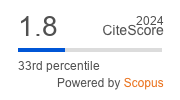Machine Learning Methods for Forecasting Intermittent Tin Ore Production
Abstract
Effective production forecasting is important for resource planning and management in the mining industry. Tin ore production from Cutter Section Dredges (CSD) may fluctuate due to a variety of factors, in which there are periods when the production is zero. This study compares various combinations of machine learning-based classification and forecasting to predict future tin ore production values, which have not been found in previous studies. The presence of zero values in the forecast in the next day's tin ore production forecast is addressed by combining classification and forecasting techniques. Random Forest and CatBoost classification techniques are used to determine the next day's CSD production operating status. Then, for each time point when the CSD is operational, a forecasting model is created using CatBoost and Bi-LSTM. This study's findings show that a serial combination of the Random Forest classification method and CatBoost forecasting can produce accurate tin ore production forecasts for the selected CSD (RMSE = 0.271, MAE = 0.179, MAE = 0.730, F1-score = 0,80). This study demonstrates how a serial combination of classification and forecasting models can improve the accuracy and efficiency of production forecasting for intermittent time series data.
Downloads
References
Y. Choi, H. Nguyen, X. N. Bui, T. Nguyen-Thoi, and S. Park, “Estimating Ore Production in Open-pit Mines Using Various Machine Learning Algorithms Based on a Truck-Haulage System and Support of Internet of Things,” Natural Resources Research, vol. 30, no. 2, pp. 1141–1173, Apr. 2020, doi: 10.1007/s11053-020-09766-5.
D. Fan, H. Sun, J. Yao, K. Zhang, X. Yan, and Z. Sun, “Well production forecasting based on ARIMA-LSTM model considering manual operations,” Energy, vol. 220, Apr. 2021, doi: 10.1016/j.energy.2020.119708.
F. Abdullayeva and Y. Imamverdiyev, “Development of oil production forecasting method based on deep learning,” Statistics, Optimization and Information Computing, vol. 7, no. 4, pp. 826–839, 2019, doi: 10.19139/soic-2310-5070-651.
C. P. Obite, A. Chukwu, D. C. Bartholomew, U. I. Nwosu, and G. E. Esiaba, “Classical and machine learning modeling of crude oil production in Nigeria: Identification of an eminent model for application,” Energy Reports, vol. 7, pp. 3497–3505, Nov. 2021, doi: 10.1016/j.egyr.2021.06.005.
B. M. Negash and A. D. Yaw, “Artificial neural network based production forecasting for a hydrocarbon reservoir under water injection,” Petroleum Exploration and Development, vol. 47, no. 2, pp. 383–392, Apr. 2020, doi: 10.1016/S1876-3804(20)60055-6.
S. Wang, Z. Chen, and S. Chen, “Applicability of deep neural networks on production forecasting in Bakken shale reservoirs,” J Pet Sci Eng, vol. 179, pp. 112–125, Aug. 2019, doi: 10.1016/j.petrol.2019.04.016.
C. Fan, N. Zhang, B. Jiang, and W. V. Liu, “Using deep neural networks coupled with principal component analysis for ore production forecasting at open-pit mines,” Journal of Rock Mechanics and Geotechnical Engineering, vol. 16, no. 3, pp. 727–740, Mar. 2024, doi: 10.1016/j.jrmge.2023.06.005.
W. Kaleem, S. Tewari, M. Fogat, and D. A. Martyushev, “A hybrid machine learning approach based study of production forecasting and factors influencing the multiphase flow through surface chokes,” Petroleum, vol. 10, no. 2, pp. 354–371, Jun. 2024, doi: 10.1016/j.petlm.2023.06.001.
X. Zhuang, Y. Yu, and A. Chen, “A combined forecasting method for intermittent demand using the automotive aftermarket data,” Data Science and Management, vol. 5, no. 2, pp. 43–56, Jun. 2022, doi: 10.1016/j.dsm.2022.04.001.
J. M. Rožanec, B. Fortuna, and D. Mladenić, “Reframing Demand Forecasting: A Two-Fold Approach for Lumpy and Intermittent Demand,” Sustainability (Switzerland), vol. 14, no. 15, Aug. 2022, doi: 10.3390/su14159295.
R. Szczepanek, “Daily Streamflow Forecasting in Mountainous Catchment Using XGBoost, LightGBM and CatBoost,” Hydrology, vol. 9, no. 12, Dec. 2022, doi: 10.3390/hydrology9120226.
İ. Güven, Ö. Uygun, and F. Şimşir, “Machine learning algorithms with intermittent demand forecasting: An application in retail apparel with plenty of predictors,” Tekstil ve Konfeksiyon, vol. 31, no. 2, pp. 99–110, Jun. 2021, doi: 10.32710/tekstilvekonfeksiyon.809867.
L. Breiman, “Random Forests,” 2001.
F. Pedregosa et al., “Scikit-learn: Machine Learning in Python,” Journal of Machine Learning Research, vol. 12, pp. 2825–2830, 2011, Accessed: Jul. 16, 2024. [Online]. Available: http://scikit-learn.sourceforge.net.
I. H. Witten, E. Frank, M. A. Hall, and C. J. Pal, Data Mining Practical Machine Learning Tools and Techniques, Fourth Edition. 2017. [Online]. Available: https://www.elsevier.com
M. Aghaabbasi, Z. A. Shekari, M. Z. Shah, O. Olakunle, D. J. Armaghani, and M. Moeinaddini, “Predicting the use frequency of ride-sourcing by off-campus university students through random forest and Bayesian network techniques,” Transp Res Part A Policy Pract, vol. 136, pp. 262–281, Jun. 2020, doi: 10.1016/j.tra.2020.04.013.
F. Zhang, H. Fleyeh, and C. Bales, “A hybrid model based on bidirectional long short-term memory neural network and Catboost for short-term electricity spot price forecasting,” Journal of the Operational Research Society, vol. 73, no. 2, pp. 301–325, 2022, doi: 10.1080/01605682.2020.1843976.
J. A. Irvin et al., “Incorporating machine learning and social determinants of health indicators into prospective risk adjustment for health plan payments,” BMC Public Health, vol. 20, no. 1, pp. 1–10, 2020, doi: 10.1186/s12889-020-08735-0.
J. T. Hancock and T. M. Khoshgoftaar, “CatBoost for big data: an interdisciplinary review,” J Big Data, vol. 7, no. 1, Dec. 2020, doi: 10.1186/s40537-020-00369-8.
A. V. Dorogush, V. Ershov, and A. G. Yandex, “CatBoost: gradient boosting with categorical features support,” in Workshop on ML Systems at NIPS 2017, 2017. [Online]. Available: https://github.com/Microsoft/LightGBM
L. Prokhorenkova, G. Gusev, A. Vorobev, A. V. Dorogush, and A. Gulin, “CatBoost: unbiased boosting with categorical features,” in 32nd Conference on Neural Information Processing Systems (NeurIPS 2018), Montréal, Canada, 2018. [Online]. Available: https://github.com/catboost/catboost
S. A. Shahriar et al., “Potential of arima-ann, arima-svm, dt and catboost for atmospheric pm2.5 forecasting in bangladesh,” Atmosphere (Basel), vol. 12, no. 1, pp. 1–21, Jan. 2021, doi: 10.3390/atmos12010100.
Sepp Hochreiter and Jurgen Schmidhuber, “Long Short-Term Memory,” Neural Comput, vol. 9, no. 8, pp. 1735–1780, 1997.
I. H. Sarker, “Deep Learning: A Comprehensive Overview on Techniques, Taxonomy, Applications and Research Directions,” Nov. 01, 2021, Springer. doi: 10.1007/s42979-021-00815-1.
M. Chovatiya, A. Dhameliya, J. Deokar, J. Gonsalves, and A. Mathur, “Prediction of dengue using recurrent neural network,” Proceedings of the International Conference on Trends in Electronics and Informatics, ICOEI 2019, vol. 2019-April, no. ICOEI 2019, pp. 926–929, 2019, doi: 10.1109/icoei.2019.8862581.
S. Siami-Namini, N. Tavakoli, and A. S. Namin, “The Performance of LSTM and BiLSTM in Forecasting Time Series,” in 2019 IEEE International Conference on Big Data (Big Data), 2019, p. 3285.
M. Abadi et al., “TensorFlow: Large-scale machine learning on heterogeneous systems,” 2015. Accessed: Jul. 17, 2024. [Online]. Available: tensorflow.org
F. Chollet and et al., “Keras,” 2015. Accessed: Jul. 17, 2024. [Online]. Available: https://keras.io
X. Zhou, P. Lu, Z. Zheng, D. Tolliver, and A. Keramati, “Accident Prediction Accuracy Assessment for Highway-Rail Grade Crossings Using Random Forest Algorithm Compared with Decision Tree,” Reliab Eng Syst Saf, vol. 200, Aug. 2020, doi: 10.1016/j.ress.2020.106931.
R. J. Hyndman, “Another Look at Forecast Accuracy Metrics for Intermittent Demand,” FORESIGHT: The International Journal of Applied Forecasting, vol. June, no. 4, pp. 43–46, 2006.
Copyright (c) 2024 Jurnal RESTI (Rekayasa Sistem dan Teknologi Informasi)

This work is licensed under a Creative Commons Attribution 4.0 International License.
Copyright in each article belongs to the author
- The author acknowledges that the RESTI Journal (System Engineering and Information Technology) is the first publisher to publish with a license Creative Commons Attribution 4.0 International License.
- Authors can enter writing separately, arrange the non-exclusive distribution of manuscripts that have been published in this journal into other versions (eg sent to the author's institutional repository, publication in a book, etc.), by acknowledging that the manuscript has been published for the first time in the RESTI (Rekayasa Sistem dan Teknologi Informasi) journal ;








